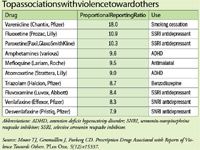Some psychoactive prescription drugs associated with violence
New data suggest that certain prescription drug products are associated with aggression and violence toward others.

Key Points
New data suggest that a variety of prescription drug products are associated with aggression and violence toward others. The list of drugs associated with reports of this serious adverse drug event includes antidepressants, sedative/hypnotics, medications for attention deficit/hyperactivity disorder, and antismoking agents.
There appears to be less risk of violence associated with antipsychotics and anticonvulsants/mood stabilizers. In fact, most prescription drugs have few or no reports of associated violence, according to drug safety researcher Thomas Moore, Institute of Safe Medication Practices (ISMP).
However, "A substantial number of drugs already carry warnings of violent acts," Moore told Drug Topics. "Pharmacists, patients, and physicians need to understand that psychoactive drugs can induce negative changes in behavior as well as positive changes."

Researchers found 78 adverse event reports in MedWatch that described acts or thoughts of aggression or violence toward others. They found 4 more cases noted in clinical trials and 3 more in the reported literature. In cases where "dechallenge and rechallenge" data were available, violence/aggression resolved in 93% of cases when varenicline was discontinued.
AERS search
Moore used the same criteria to search the entire FDA Adverse Event Reporting System (AERS). Researchers extracted any case report that indicated homicide, homicidal thoughts, physical assault, physical abuse, or violence-related symptoms. They found 484 drugs for evaluation. A subset of 31 drugs accounts for 79% of all reported cases of violence or aggression.
Unprovoked attacks
The cases were clearly unusual, Moore said. Reports included a woman who attacked her 17-year-old daughter while the daughter was driving a car, a man who suddenly punched a stranger in a bowling alley, and a young woman who started beating her boyfriend in bed because he looked so peaceful.
"These events have striking common features," Moore said. "They were unprovoked and inexplicable; the victim was anyone who happened to be nearby; the patient had no prior history of similar violent or aggressive behavior; and the onset of psychiatric adverse events came early in the course of treatment, often after just 1 or 2 doses. This is a very clear association. It is an eruption of rage, and the target can be anyone who happens to be around."
Other cases included attacks on police, friends, office workers, strangers, household items, and vehicles. Some victims were killed; some patients attempted suicide. The data suggest an overlap between violence toward others and suicidal actions.
"Pharmacists should pay attention to the fine print," Moore said. "Warnings about thoughts and acts of violence are already there. Thinking about violence toward others is just a shift in emphasis."